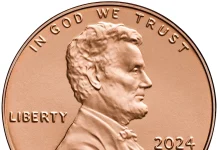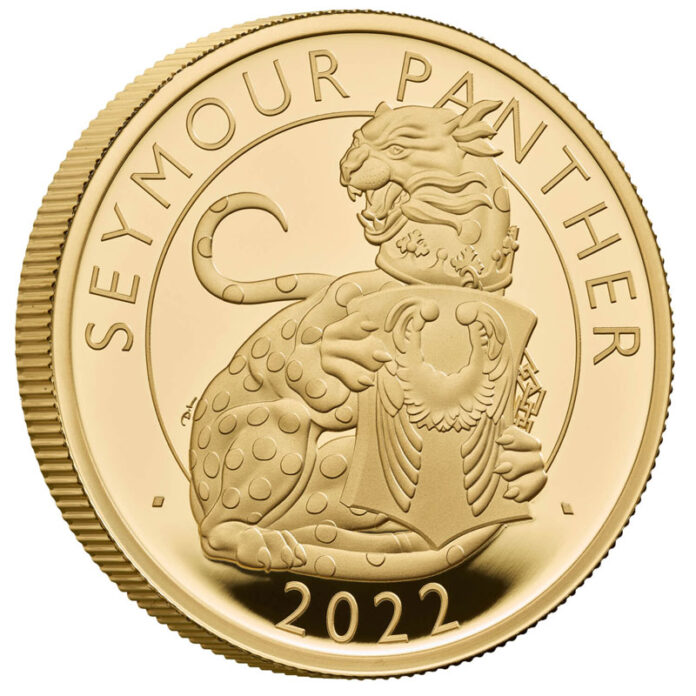
It has been a time in British history like none other: a farewell to seven decades of one monarch and the start of a long-anticipated new reign. Buckingham Palace has announced May 6, 2023, as the official coronation day of King Charles III and a coin has been struck with his visage facing left, opposite (per tradition) the direction of the late Queen Elizabeth II.
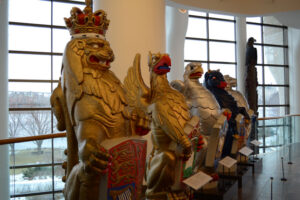
Like the solemn exchange of one royal coinage portrait for another, so too have royal honor guards been exchanged: history has retired the heraldic figures known as The Queen’s Beasts, who protected their monarch’s entrance into Westminster Abbey. In their stead, The Royal Mint has cast a new coin series concurrent with a new king: The Royal Tudor Beasts.
Faithful & Fierce
Having completed their honorary duties, the remaining figures in The Queen’s Beasts collection by Jody Clark for The Royal Mint deserve a nod for their timeless symbolism. These recast figures include a unicorn and much like that mythical beast, the greater the elusiveness of these pre-2023 coins, the more satisfying their hunt and capture will be.
The Unicorn of Scotland
Like the Lion of England (the first coin struck in The Queen’s Beasts series), the Unicorn of Scotland (the second coin) epitomizes the supporters of the Royal Arms not simply as a royal badge but as figureheads of the monarchy and the United Kingdom (including on British passports). The Unicorn and Lion were the first released in Brilliant Uncirculated editions to make them available to wider audiences and proved so popular they went out of stock.
The Red Dragon of Wales
As an emblem, the red dragon has been used since 655 A.D., when the reigns of Cadwaladr, King of Gwynedd, and leaders of Celtic Britons were personified as “dragons.” It remains a symbol of Wales and has been present on its official flag since 1959. “Red dragon” in Welsh translates to Y Ddraig Goch. The Limited Edition (150) Silver Proof Kilo coin in this series was the largest and most exclusive silver coin in The Royal Mint set. Collectors now must, like the myth of St. George, seek out their own red dragon to conquer. The coin is no longer issued.
The Black Bull of Clarence
This bovine symbol of power and strength has appeared on shields since 1461, when the House of Lancaster was defeated and Edward IV was declared the first Yorkist king of England. In the 1560s, when Elizabeth I ordered the recoinage of all silver coins, the bull figured not only on coins but The Royal Arms, and in 2018, this Black Bull of Clarence was released to commemorate Elizabeth II’s 65th anniversary on the throne. Albeit out of stock through The Royal Mint, collectors can watch for bulls that may “jump their fence” and re-enter the market, like a UK One Ounce Silver Proof, UK Ten Ounce Silver Proof or UK Silver Proof Kilo coin.
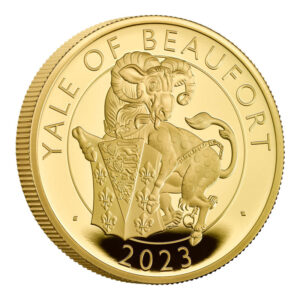
The Yale of Beaufort
This mythical amalgam had the body of a goat, the tusks of a boar and the tail of a lion – all the size of a hippo! It came to The Queen’s heritage through Henry VII, who inherited it from his mother, Lady Margaret Beaufort. A central figure in the Wars of the Roses, Lady Margaret’s position as matriarch of the Tudor dynasty gives the Yale its symbolic gravitas. Released in 2018, concurrent with the 65th anniversary of The Queen’s coronation, The Yale was available to a range of collectors, from a UK £5 Brilliant Uncirculated to a UK Gold Proof Kilo coin.
The Falcon of the Plantagenets
In heraldry, the falcon’s fierce countenance represents single-minded intent but also belies the tender regard Plantagenet King Edward III held for his favorite pastime, hawking. The falcon and fetterlock depicted also symbolizes Edward IV, who claimed the throne during the Wars of the Roses. As swift as a falcon was the sell-out success of this coin, the fifth in The Queen’s Beasts series and the most limited (5,500) of its Limited Edition Presentation coins. A UK One Ounce Silver Proof flew to the top of collectors’ lists, equaling Lion, Unicorn and Dragon coins in popularity.
Welcome, the Tudor Beasts
The creator of the original figures known as The Queen’s Beasts, James Arthur Woodford, was inspired by a series of statues created 400 years earlier for Henry VIII, known as The King’s Beasts, that lined and protected The Moat Bridge at Hampton Court Palace. After the House of Lancaster defeated the House of York in the Wars of the Roses, new symbols of heraldry were born through the union of Henry VII to Elizabeth of York. At Hampton Court, Henry VIII as a boy would have grown up among those heraldic images, inspired to keep the Tudor dynasty safe with beastly guardians of his own.
Now 10 stone beasts, representing the lineage of Henry VIII and his third wife, Jane Seymour, compose the newest coin collection by The Royal Mint, designed by illustrator and sculptor David Lawrence, and known as The Royal Tudor Beasts Collection. Over five years, 10 coins will see release: The Seymour Panther, Lion of England, Greyhound of Richmond, Yale of Beaufort, Tudor Dragon, Royal Dragon, Seymour Unicorn, Queen’s Panther, Black Bull of Clarence and The Queen’s Lion.
Released in late 2022, The Seymour Panther symbolizes the union between Henry VIII and Jane Seymour, who died less than two weeks after the birth of their only child, the future King Edward VI, and is the only one of his six wives to receive a queen’s funeral or be interred alongside him at St. George’s Chapel. At the time of press, The Seymour Panther 2022 UK Silver Proof Two-Coin Set (Limited Edition 1,000) was available to order, as was the 2022 UK £5 Brilliant Uncirculated Coin, and 2022 UK 1kg Silver Proof Coin (Limited Edition 70), while a quarter-ounce Gold Proof Coin is selling robustly.
Also in stock and available to order are The Lion of England, in UK £5 Brilliant Uncirculated, Limited Edition Silver Proofs, UK 1oz. and 2 oz. Silver and Gold Proof coins, 2022 UK Silver Proof Two-Coin Limited (1,000) Edition Sets, and a 2022 1 oz. Gold Bullion Coin (currently 90% reserved). This snarling figure assumed royal beast status in the 12th century during King Richard II and was used by Henry VIII as his heraldic dexter (left-hand) supporter. It was among the first beasts to flank the parapets at the Moat Bridge of Hampton Court Palace, where its crowned lion’s shield bears the impaled, or combined, coats of arms of Henry and Jane.
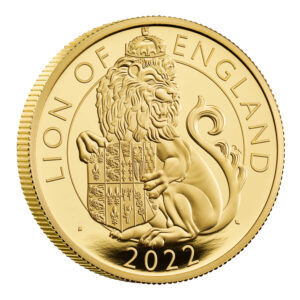
Making the Mythic Natural
The challenge for creator David Lawrence, whose 30 years’ experience includes with The Royal Mint commemorating World War I, has been “to depict the heraldic beasts – loaded with the symbolic meaning that lies behind heraldry – in a natural and realistic way.”
“The beasts we see on the Moat Bridge at Hampton Court Place are very stylized, in the sense that they are created through a Tudor frame of reference. The Tudors would draw beasts that they had never seen, basing their interpretations off reports or word-of-mouth,” Lawrence said in Meet the Maker, on RoyalMint.com.
“Therefore these beasts are roughly 70% fictionalized. I was lucky, in that I received an extremely detailed briefing document from The Royal Mint that included photographs, coupled with extensive background information. The beasts became my primary source of inspiration, as they stand in situ on the Moat Bridge. My aim was to take inspiration from the Tudor-carved beasts and modernize them, without losing their historical or heraldic importance.”
One look at The Royal Tudor Beasts and it’s easy to admit, never have figures of such mythic proportions fit so easily in the hands of coin collectors.
This article about the Royal Tudor Beast coins previously appeared in COINage magazine. To subscribe click here. Column by LA Sokolowski.



